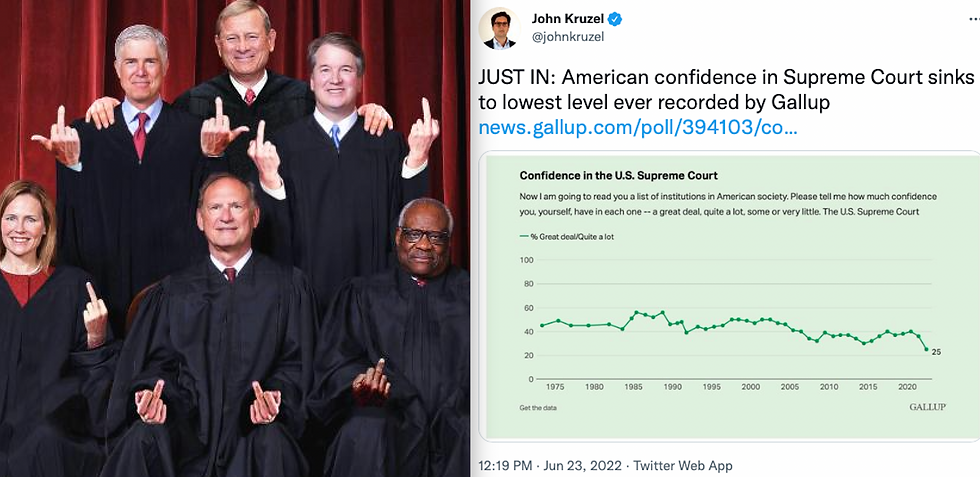Increasing The Size Of The Supreme Court Shouldn't Be Controversial-- It's About Much Needed Reform
- Howie Klein

- Jul 2, 2022
- 3 min read

It isn’t that big a deal to increase the number of Supreme Court justices. In fact, the number really should be 13, not 9. The Constitution doesn’t say anything about how many justices should sit on the Supreme Court other than leaving the decision to Congress. The number was originally set at 6 (1789) but was reduced to 5 a dozen years later (1801), a partisan decision. In 1807, Congress increased the number to 7 "in response to the geographic expansion of the nation and the increased caseload of the district courts in the west. The act established a Seventh Circuit, consisting of Ohio, Kentucky, and Tennessee, and specified that the new justice be assigned to preside over the U.S. circuit courts within that circuit.” As new states were added and the number of circuits increased, so did the number of justices. Two new circuits and two seats were added in 1837. Almost immediately after his election, in his first message to Congress, Andrew Jackson wrote:
In this general survey of our affairs a subject of high importance presents itself in the present organization of the judiciary. An uniform operation of the Federal Government in the different States is certainly desirable, and existing as they do in the Union on the basis of perfect equality, each State has a right to expect that the benefits conferred on the citizens of others should be extended to hers. The judicial system of the United States exists in all its efficiency in only fifteen members of the Union; to three others the circuit courts, which constitute an important part of that system, have been imperfectly extended, and to the remaining 6 altogether denied...To extend the circuit courts equally throughout the different parts of the Union, and at the same time to avoid such a multiplication of members as would encumber the supreme appellate tribunal, is the object desired.
There was a big change in 1866, a totally partisan one because the Republican-controlled Congress didn’t want to allow the hated Andrew Johnson to appoint any justices. That reorganization of the system brought down the number of circuits from 10 to 9 and Congress reduced the number of justices by 3, from 10 to 7. Three years later Congress decided that didn’t work and decided to increase the number again, so that there would be one justice responsible for each circuit, as the original Judiciary Act of 1789 (signed by George Washington) had mandated. The last change came in 1869 when the size increased to 9, again, one for each circuit.
The problem the Supreme Court has now began in 1929 when a 10th Circuit was created for Wyoming, Colorado, Utah, New Mexico, Kansas and Oklahoma... but no expansion of the size of the Supreme Court. Caseloads were too heavy— as they are now— and the Court complained to Congress. In 1980 Congress attempted to reduce the caseload by adding an 11th circuit— Alabama, Florida and Georgia— but, again, foolishly, no expansion of the number of justices.
Today there are 13 circuits— 11 plus one for DC and another known as the U.S. Court of Appeals for the Federal Circuit. But there are only 9 overworked-to-the-point-of-breakdown justices of the Supreme Court. In fact, that may even be why 5 or 6 of them have lost their minds and are issuing grievously wrong rulings harmful to the country and to the American people.

Remember, according to the Constitution, Congress can make any change it wants for any reason at any time, and tradition— and common sense— would dictate 13 justices, one for each circuit. Congress has made changes to the number of justices 7 times and it’s time to do it again. And not only because of the number of circuits. Since 1869, the last time the court was expanded, the country’s population has grown by over 800%!
Alan Grayson is currently running for his old Orlando-based congressional seat. He graduated from Harvard magna cum laude and Phi Beta Kappa and also graduated from Harvard Law cum laude. But before his stint in Congress, he clerked for both Ruth Bader Ginsburg and Antonin Scalia. He’s a natural person for me to discuss Court questions. (He’s also a practicing attorney and a deep thinker; just sayin’.) “The Court,” he told me last night, “needs to be unpacked, for sure. Presently, that would require at least four more Biden justices. But also, given the fact that the Supreme Court refuses to hear 99% of the cases that it is asked to decide, the court needs to be MUCH bigger. India’s Supreme Court has 32 judges. That sounds like a good start.”







"there are only 9 overworked-to-the-point-of-breakdown justices of the Supreme Court. In fact, that may even be why 5 or 6 of them have lost their minds and are issuing grievously wrong rulings harmful to the country and to the American people."
really? overwork instead of nazi partisanship? that sentence ruined an otherwise useful piece.
1) you're asking democraps to do what democraps refuse to do... their fucking jobs.
2) you're forgetting that biden adding 4 would probably be giving moscow's bitch 2 nazis because biden likes bipartisanship and the money would fear a court that would be even slightly liberal or progressive. and biden is devoted to the money.
3) and even if democraps accidentally expanded the court, there would…